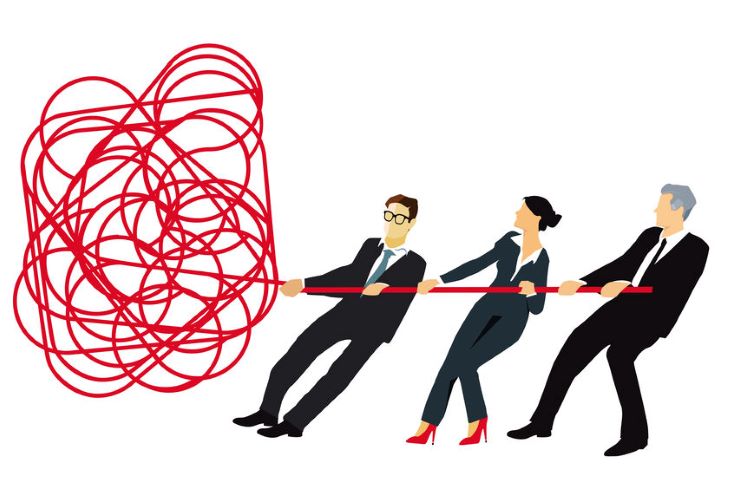Stakeholder mapping: Untangling problems before, during and after a crisis
Globalisation and the increasing interdependence of our societal systems are generating multiple levels of stakeholders that are a challenge to engage with in normal times but that become a nightmare to manage in a crisis. Besides employees, regulators, politicians, victims, customers and shareholders, organisations now also have to reckon with other stakeholder groups that become involved through social media networks. The multitude and diversity of these intertwined stakeholder groups are compounding the intensity of crises. Overall, we are witnessing more stakeholder outrage at corporate and institutional misbehaviour, writes Caroline Sapriel of CS&A International.

CS&A International's stakeholder mapping tool, Untangle, allows crisis teams to anticipate and mitigate stakeholder curve balls and focus on the areas they can influence. Image: scusi|123rf
Statistics from the Institute of Crisis Management’s 2018 annual report show that 67 per cent of business crises worldwide are non-event-related or smouldering crises.
Often the problem or issue exists long before it goes public, yet little is done to address and resolve it. Or, what is worse, it is hushed up, and then it suddenly escalates. A single trigger - a rumour, a leak, or a stakeholder action - can catapult an organisation into crisis in a very short time, with devastating effects - on the very ability of the organisation involved to continue to operate and on the affected stakeholders.
In today’s digital age, an issue or unfolding crisis spreads like wildfire. With the Internet’s light-speed dissemination of information and disinformation, social networks, blogs and online news sites are channelling and ballooning the attention and the scrutiny on crises and scandals.
Ultimately, the ability to retain stakeholder trust is the differentiating factor between a crisis and a reputation melt-down.
In this context, stakeholder mapping is a critical skill that no crisis team can afford to do without. To anticipate, prevent and mitigate crises, crisis leaders must have a solid grasp of the climate in which they are working as well as the stakeholder scene surrounding any emerging issue. A list drawn up on the fly is not stakeholder mapping. It is a list and will remain nothing more. Under acute time pressure, crisis teams need an easy-to-follow mapping process that will cut to the chase, help them anticipate and mitigate stakeholder curve-balls and focus on the areas they can influence.
With years of experience working with crisis teams around the world, CS&A International has developed its own fast-track stakeholder mapping tool - Untangle. Useful before, during and after crises, Untangle systematically maps stakeholders through a series of steps that prioritises and categorises them, identifies their specific issues, defines positions and potential actions so that, ultimately, a desired outcome, strategy and key messages can be formulated.
Good stakeholder mapping allows teams to anticipate ways that stakeholder actions can cause the situation to worsen and therefore can help them stay ahead of the curve.
No two crises are ever the same. No one can predict exactly how long a crisis will last, how it will twist and turn, and how and where it will end up. What is always almost certain though, is that the situation will get worse before it gets better. Therefore the link between stakeholder mapping and the ability to develop worst-case scenarios cannot be overstated.
Under the high-stress conditions of a crisis, worst-case scenario planning helps the team pursue a dominant strategy related to the likely worst-case development. This is not a matter of gazing into a crystal ball to predict the future, but rather a powerful methodology to be ready for possible crisis escalations.
“The great virtue of the scenario approach to planning,” write Charles Hill and Gareth Jones in their book Strategic Management Theory: An Integrated Approach, “is that it can push managers to think outside the box, to anticipate what they might have to do in different situations, and to learn that the world is a complex and unpredictable place that places a premium on flexibility, rather than on inflexible plans based on assumptions about the future that may turn out to be incorrect.”
Therefore, especially during crises, the ability to develop different worst-case scenarios is invaluable. It empowers the team to be pro-active and helps foster a positive and productive mind-set, which is essential during the inevitable downtime periods that occur in every crisis response cycle.
All of today’s crises have one thing in common - acute stakeholder pressure before, during and after. In the highly unpredictable nature of crises, the task of actively mapping and engaging with stakeholders is a make or break opportunity every business leader should pursue to mitigate the escalations and impacts of crises and potentially to emerge stronger from them.
This blog was sponsored by CS&A International, a globally recognised leader in the field of risk, crisis and business continuity management. For more details, visit its website here. To find out more information about our sponsored blogs, contact claire@crisis-response.com
Caroline Sapriel, 20/09/2019